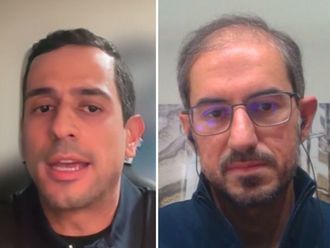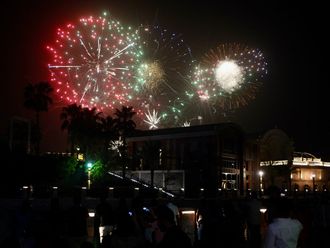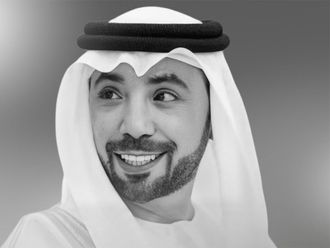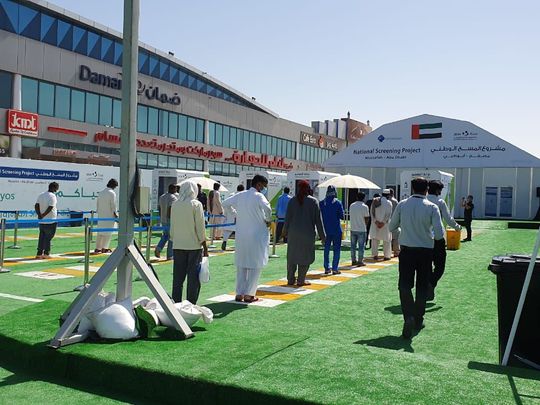
Abu Dhabi: Nearly 25,000 residents are being screened every day as part of the National Screening Project launched in Abu Dhabi last week to detect the spread of the coronavirus.
During a media tour of one of the biggest dedicated screening facilities today (May 6), senior doctors said about 20 per cent of those screened have mild to severe symptoms or risk factors.
“Over the next two weeks, we aim to test about 335,000 people living and working in Musaffah, as it is one of the most densely populated areas in the capital,” said Dr Noura Al Ghaithi, chief operations officer at Ambulatory Healthcare Services (AHS), which operates clinics under public health provider, Abu Dhabi Health Services Company (Seha).
Screening in Musaffah
The AHS is operating two screening centres in Musaffah, with a third expected to open next week. The biggest of these, which was toured by dignitaries and media today (May 6), spans 3,500 square metres, and it helped increase the emirate’s screening capacity by 80 per cent when it opened on April 30.
“Based on yesterday’s screenings, about five per of the people tested had severe symptoms or risk factors. They are triaged into the red category, and we take their nasal swab first. Then, a physician evaluates them, performing a blood test, chest x-ray and electrocardiogram to determine whether they need to be immediately admitted at a hospital or quarantined till test results are available,” explained Dr Khulood Al Dhaleei, director of Abu Dhabi clinics at the AHS.
“We want to detect positive cases as soon as possible and stop the [coronavirus] spread,” added Dr Al Ghaithi.
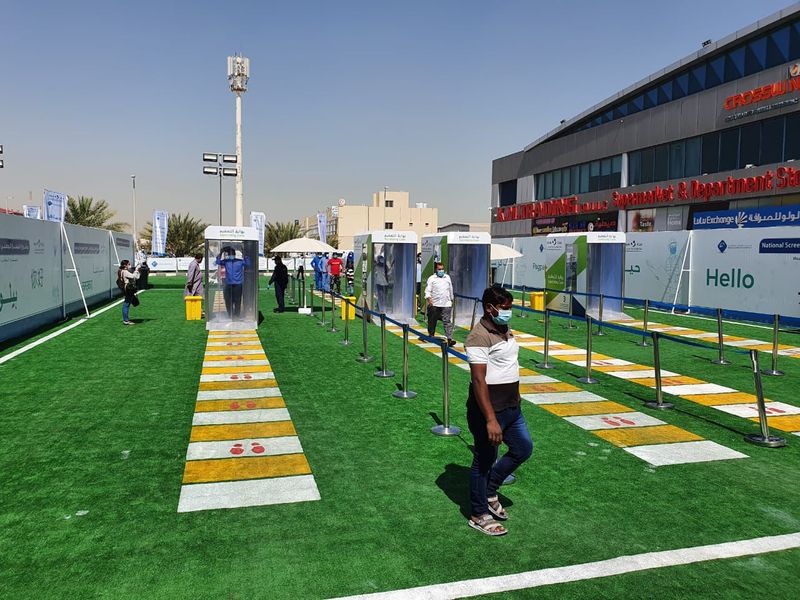
Screening process
The tests are being conducted in collaboration with transport and security authorities, with companies bringing in busloads of workers and employees for screening as soon as the centres open at 9am.
Each facility is divided into multiple zones to ensure that testing takes the least amount of time, Dr Al Ghaithi said.
After visitors pass through a sanitisation gate, the first zone assembles visitors, with digital displays detailing the screening steps. Floor markers throughout the facility indicate where people can stand to ensure adequate social distancing.
Visitors are then ushered into the triaging zone, which includes overhead signs listing coronavirus preventive measures in six languages. Thermal scanners at the entryway monitor body temperature, and flags those with elevated readings. A healthcare worker follows up with questions about the person’s health.
Those without symptoms or risk factors, including age and chronic conditions, are registered and allowed to leave. Those with mild symptoms or risk factors are given yellow wristbands, and others with severe symptoms and risk factors receive red wristbands.
These visitors are then directed to the testing area, where a nurse administers a nasal swab with gloved hands from inside a sealed cabin. Following the swab, those with yellow wristbands are handed informational materials, along with a pair of gloves, masks and hand sanitisers and allowed to leave the facility. Others with red wristbands are held back for further evaluations.
Test results are available within 48 hours, via dedicate lab that processes them, said Mohammad Al Sadid, chief executive officer at AHS.
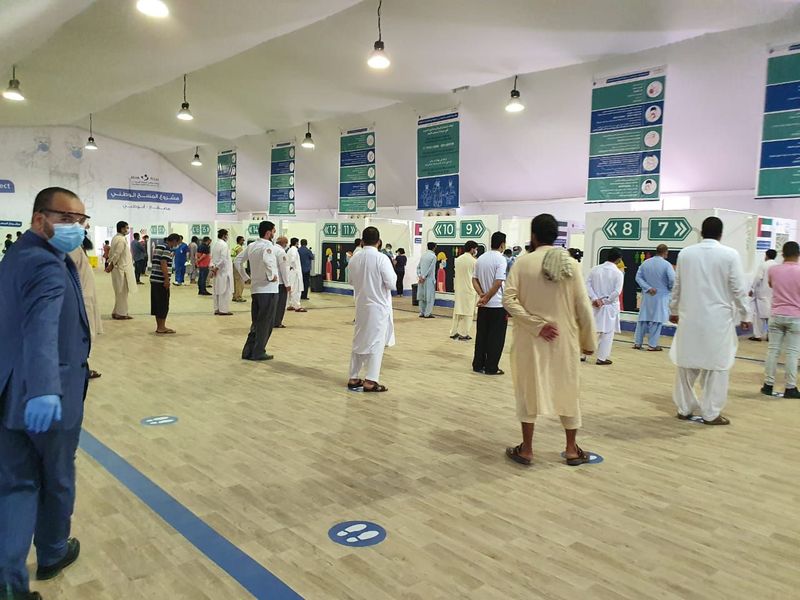
Testing access
The UAE has completed over one million tests since recording its first case in late January, placing the nation sixth globally in terms of tests administered per country. The new screening facilities are expected to increase this number significantly.
“Testing access is widespread in the UAE. In Abu Dhabi, we have the drive-through testing facilities, as well as all healthcare facilities,” Dr Al Ghaithi said.
Who is being tested?
About 85 per cent of those being screened in Musaffah, a primary industrial zone in the capital, are currently men, but there are fast-track queues for women and children. For now, authorities are focusing on employees, and those living in shared housing facilities.
Dr Al Ghaithi said Indians, Filipinos, Pakistanis, Egyptians, Bangladeshis and Nigerians make up the majority of people screened in Musaffah.
The main AHS screening centre in Musaffah is located behind the ADNOC Vehicle Inspection Centre. Al Sadid said it can perform about 10,000 tests a day.
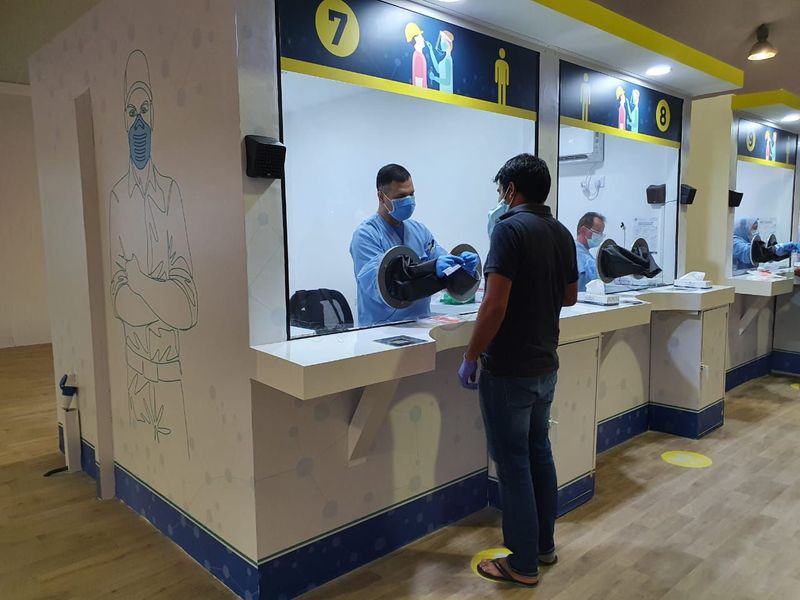
Indian Ambassador to the UAE, Pavan Kapoor, and Filipino Ambassador Hayceelyn M. Quintana, today visited the centre, with more diplomats expected in the coming days.
A second AHS screening centre is located near the Bazaar in sector M42, and third is being set up in sector M1. These two facilities will be able to screen 7,500 people on a daily basis.
Two other private facilities are working with the National Screening Project: Mubadala Healthcare’s Capital Health Screening Centre in M12, and a Burjeel Hospital facility in M12, next to Al Masaood.



